Featured Application
The investigated protic ionic liquid could be used as an additive in water-based lubricating fluids for hydraulic or metalworking applications.
Abstract
Recently, environmentally friendly lubricants and their additives have been of great interest. Using such lubricants can provide a few benefits, namely: nontoxicity and biodegradability when exposed to groundwater or soil. Moreover, renewable raw materials could be used to produce these lubricants. This study aims to synthesize bis (2-hydroxyethyl)ammonium erucate protic ionic liquid containing a renewable counterpart-erucic acid. The synthesis of bis (2-hydroxyethyl)ammonium erucate, its physical properties, solubility in the base lubricating fluid, and tribological properties were evaluated. The study shows that even though the investigated protic ionic liquid is liquid at room temperature, it has a very high kinematic viscosity, which drops when the temperature increases. Bis (2-hydroxyethyl)ammonium erucate can be dissolved in water up to 3 wt%. It also has excellent lubricity when used as a neat lubricant and could be successfully applied as a lubricity-enhancing additive in water.
Keywords:
lubricant; additive; environmentally friendly; fatty acid; protic ionic liquid; friction; wear 1. Introduction
The industry’s growth is inseparable from the increase in and complexity of mechanisms, leading to the usage of various lubricants. According to statistical data, the global demand for lubricants was 37 million metric tons in 2020 [1]. Unfortunately, almost one-third of this amount ends up in the environment and causes pollution [2,3]. According to the entry methods into the environment, lubricants can be categorized as (i) lubricants used in closed systems and (ii) total loss lubricants. The lubricants from the first category can be collected. They enter the environment only due to leakage or during accidents. On the other hand, lubricants from the second category enter the environment after their first usage. Therefore, there is no possibility of collecting. Consequently, the former lubricants must be nontoxic, readily biodegradable, and, if possible, produced using renewable raw materials [4,5].
Researchers have already suggested several environmentally friendly lubricants and their additives for a few decades that could replace the existing harmful ones [3,6,7,8,9,10]. Vegetable oil-based lubricants were the first choice for many researchers and industrial applications. Owing to the inherent biodegradability, nontoxicity, and excellent lubricity of vegetable oils, they were suggested for various applications: metalworking fluids [11], engine oils [12], chain saw oils, hydraulic fluids [13], etc. However, despite the applied additives, poor oxidation stability limits their wider application. Another environmentally friendly lubricant alternative is water. Undoubtedly, it is an easily accessible, renewable, low-cost base fluid. In addition, additive-loaded water-based lubricating fluids possess excellent cooling capacity, good lubricity, and non-flammability [3,14]. Due to the mentioned advantages, water-based lubricating fluids are widely applied in industry, particularly in metalworking and hydraulics [3]. Unfortunately, toxic additives with sulfur, phosphorus, and chlorine are used to enhance the tribological properties of water-based fluids. Therefore, various environmentally friendly alternatives are suggested [2,14,15,16]. The third environmentally friendly lubricant alternative is synthetic esters. These substances can have desired properties and perform well when used with the proper additive package [13,17,18]. However, the main drawbacks limiting their application are the very high costs and complex synthesis procedures. Considering the above facts, environmentally friendly lubricants are not widely acknowledged due to performance drawbacks or considerably higher costs. Therefore, seeking new attractive lubrication materials at lower prices is essential to improve the usage of environmentally friendly lubricants. Consequently, it will lead to pollution reduction.
Nanoparticles and ionic liquids have recently become the most exciting lubrication substances [19,20,21,22,23,24]. Ionic liquids can be used as neat lubricants or lubricity-enhancing additives. Moving towards the development of environmentally friendly lubricants, protic ionic liquids (PILs) have been suggested [25,26,27]. Protic ionic liquids can be synthesized in a relatively simple acid-base neutralization reaction, investigated by Walden in 1914 [28].
A few studies have confirmed the superior lubricity and the versatile applications of PILs. Espinosa and coauthors revealed that triprotic ionic liquid bis (2-hydroxyethyl ammonium) succinate could be used as a neat lubricant or lubricity-improving additive in water-based fluids [26]. Aviles et al. suggested stearic and palmitic fatty acid anions containing PILs [29]. It was revealed that using PILs as additives in the water to lubricate the sapphire-stainless steel friction pair resulted in an 80% lower coefficient of friction.
Usually, PILs only comprise C, O, and N elements and contain no heteroatoms. Therefore, the adsorption of polar molecules was noted to be responsible for their lubricity [30]. Usage of PILs results in worn surface oxidation-reduction and, consequently, less wear [27].
This paper aims to present the tribological properties of a newly synthesized protic ionic liquid bis (2-hydroxyethyl)ammonium erucate. The distinct feature of this PIL is a long-chain carboxylic acid anion, which is expected to show better lubricity compared to shorter-chain alternatives. Bis (2-hydroxyethyl)ammonium erucate was used as a neat lubricant and an additive in water to demonstrate its performance. First, its physical and tribological properties were investigated. Then, lubrication mechanisms were discussed and compared with the existing alternatives.
2. Materials and Methods
2.1. Synthesis of Bis(2-hydroxyethyl)ammonium Erucate Protic Ionic Liquid
Erucic acid (CAS No. 112-86-7) was obtained from Alfa Aesar (Kandel, Germany). Bis(2-hydroxyethyl)amine (CAS No. 111-42-2) was obtained from Acros Organics (Darmstadt, Germany). All the reagents were analytical grade. Therefore, they were used as such without any preparation.
Generally, during the alkylation of the amine, a reaction between the ammonium cation (secondary amine) and the carboxylic acid anion occurs [31], as shown in Figure 1.

Figure 1.
Scheme of amine alkylation.
To synthesize bis(2-hydroxyethyl)ammonium erucate, the bis(2-hydroxyethyl)amine was alkylated using erucic acid, with a 1:1 molar ratio. An acid-base neutralization reaction occurs in this process, forming a protolytic ionic liquid (PIL). The synthesis was carried out in a thermostated three-necked flask connected to a reflux condenser, a thermometer, and a dropping funnel. First, the thermostated flask was placed in a glycerol bath to equilibrate the mixture’s temperature. Then, erucic acid was added to the flask and heated to 100 °C while constantly stirring (400 rpm). When the required temperature was reached, the bis(2-hydroxyethyl)amine was added dropwise (6 drops/min). Furthermore, the reaction continued at a temperature of 100 °C for 24 h. The scheme of bis(2-hydroxyethyl)ammonium erucate formation is shown in Figure 2.

Figure 2.
Scheme of bis(2-hydroxyethyl)ammonium erucate formation.
The formation of the IL-DEE was inspected using Fourier transform infrared (FTIR) spectroscopy. The FTIR spectra were taken using a JASCO FT/IR-4X Spectrometer (Tokyo, Japan). The scan range was set to 4000–500 cm−1, with an accumulation of 50 and a resolution of 4 cm−1.
Figure 3 presents FTIR spectra of bis(2-hydroxyethyl)ammonium erucate. The absorption band appearing in the range of 1800–1400 cm−1 is of low intensity and is characteristic of carbonyl, (C = O) stretching, and (N-H) plane bending vibrations, while 3000–2800 cm−1 confirms the distinct ammonium peak, (N-H), and (O-H) stretching vibrations. In addition, a peak at 722 cm−1 is visible in the spectrum, indicating the presence of alkyl chains with at least four consecutive methylenes (-CH2-).
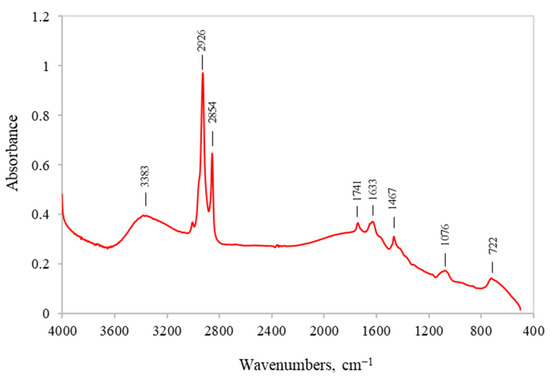
Figure 3.
FTIR spectra of bis(2-hydroxyethyl)ammonium erucate.
2.2. Preparation of Samples
The synthesized bis(2-hydroxyethyl)ammonium erucate was used as a neat lubricant (IL-DEE) and an additive in water (W + IL-DEE). The deionized water was selected as a base fluid. Solutions with 0.5, 1, and 3 wt.% of IL-DEE in water were prepared to evaluate its solubility. A magnetic stirrer operating at 300 rpm at room temperature blended IL-DEE in water. The blending resulted in a light yellow opaque solution, where the opacity increased with the concentration. The appearance of prepared solutions is presented in Figure 4. It is evident from the image that bis(2-hydroxyethyl)ammonium erucate is soluble in water within the investigated concentration range. Moreover, it showed no sedimentation or clouding within several days. Furthermore, solutions with one wt.% of PIL were used for lubricity evaluation.

Figure 4.
The appearance of investigated lubricating fluids.
2.3. Physicochemical Properties
The viscosity and density of synthesized IL-DEE were examined at temperatures ranging from 20 to 100 °C. At higher temperatures, the W + IL-DEE solution tends to evaporate, which leads to inconsistent results. Therefore, its properties were examined in the temperature range from 20 to 70 °C. In both cases, the SVM 3000 Anton Paar viscometer was used to investigate viscosity and density.
2.4. Tribological Properties and Worn Surface Evaluation
The tribological properties of prepared samples were investigated using a ball-on-plate reciprocating tribometer TR-282 (Ducom, India). The principal test scheme is shown in Figure 5, while test conditions are shortly summarized in Table 1. During the test, a 6 mm diameter ball made of bearing steel E-52100 was rubbed against the plate made of the same steel. The hardness and surface roughness of ball and plate specimens were 850 HV and 0.05 µm, and 190 HV and 0.02 µm, respectively. The surfaces were only slightly lubricated when IL-DEE was investigated as a neat lubricant. Samples of 1 mL were used when the W + IL-DEE was examined. During the tribo-test, the variation of the coefficient of friction was recorded, and its mean value was calculated from the last 20 min of the test.
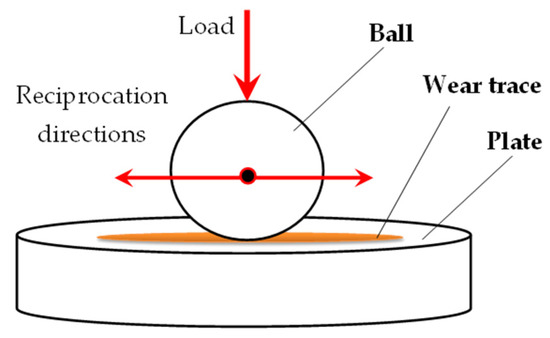
Figure 5.
Schematic view of the ball-on-plate tribo-test used in this study.

Table 1.
Summary of ball-on-plate tribo-test.
The worn surfaces were inspected using an optical microscope Nikon ECLIPSE MA 100 and a scanning electron microscope (SEM) Hitachi 3400N. Bruker Quad 5040 energy dispersive spectroscopy (EDS) analysis was used to inspect the worn surface composition. Before inspection, the specimens were rigorously cleaned in ethanol. The cross-section profiles of the wear traces were measured in a few places throughout the wear trace using a Mahr GD-25 stylus profilometer. Finally, the areas of the cross-section profiles and the wear volumes were calculated.
The coefficient of friction, wear volume, and wear scar diameter were the main characteristics of lubricity evaluation.
3. Results and Discussions
3.1. Physicochemical Properties of Investigated PIL
The physical properties of synthesized PIL are shown in Figure 6.
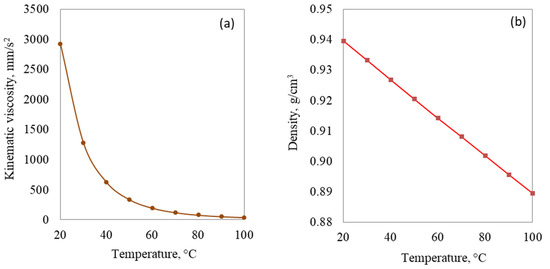
Figure 6.
Kinematic viscosity (a) and density (b) of bis(2-hydroxyethyl)ammonium erucate as a function of temperature.
Due to the long alkyl chain erucic acid anion, the synthesized protic ionic liquid bis(2-hydroxyethyl)ammonium erucate exhibited very high viscosity at room temperature. The erucic acid itself has a melting point of 28–32 °C. Therefore, such anion containing protic ionic liquid possesses high viscosity. However, the kinematic viscosity sharply drops at higher temperatures, showing the exponential temperature-viscosity relationship (Figure 6a). The exponential relationship is a characteristic feature of lubricants. Furthermore, it has been determined that IL-DEE has a viscosity index of 88.6. The viscosity index is a unit-less parameter showing how viscosity change relates to temperature change. The lower value shows a higher viscosity change. Therefore, there was a dramatic difference in viscosity between temperatures of interest, namely—1271.7 mm2/s at 30 °C and 74.2 mm2/s at 80 °C. Such a difference can undoubtedly lead to a different tribological response. Generally, having a higher viscosity index is better, because it leads to fewer viscosity changes during operation. The temperature-density relationship has a linear trend, decreasing in density while the temperature increases (Figure 6b).
Introducing such a high-viscosity additive into water increased the solution’s viscosity (Figure 7). However, the increment is temperature-related—higher differences occur at a lower temperature. This relationship is related to the physical properties of IL-DEE, where a wide viscosity range, moving from a low to a high temperature, was observed.
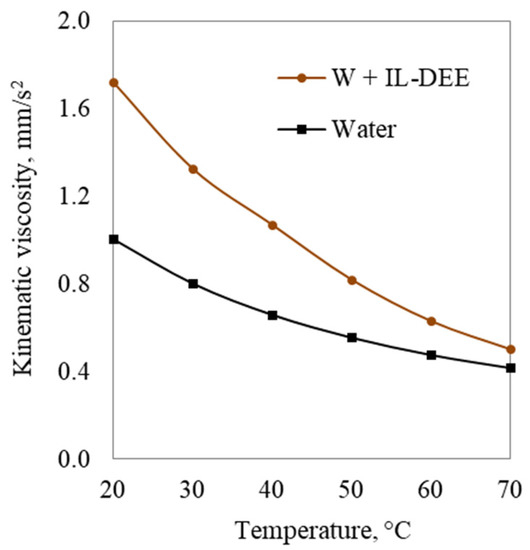
Figure 7.
Kinematic viscosity of pure and 1% of IL-DEE-loaded water as a function of temperature.
3.2. Lubricity of PIL as a Neat Lubricant
To be considered a good lubricant, one must ensure low friction and wear-reduction ability. In the present case, bis (2-hydroxyethyl)ammonium erucate demonstrated excellent lubricity at both temperatures of interest. Figure 8 shows the variation of the coefficient of friction during the test and its mean value.

Figure 8.
Variations of the coefficient of friction and its mean value observed during the PIL tribo-test. * friction coefficient values observed in our previous study [32].
The results show very low and relatively stable friction. At the temperature of 30 °C, the friction was steady throughout the test period. However, at a higher test temperature, the variation pattern changed. There was a sharp rise at the test’s onset, followed by a continuous decline throughout the test. This variation resulted in considerably lower friction observed at a higher test temperature. The reason behind that could be the temperature-induced viscosity change. At the lower viscosity, thinner interacting surfaces separating film was formed, resulting in less energy required to move interacting surfaces.
A comparison with the results from our previous study was performed to determine the influence of fatty acid anions. In that case, bis (2-hydroxyethyl)ammonium oleate was used as a neat lubricant [32]. The combination of bis(2-hydroxyethyl)ammonium cation with erucic acid shows clear friction improvement compared to oleic acid. Furthermore, the increased chain length reduced the coefficient of friction by approximately 30 and 50% at the test temperatures of 30 and 80 °C, respectively (Figure 8). Erucis acid has a longer alkyl chain (C 22:1) than oleic acid (C 18:1). Therefore, a thicker and denser adsorbed layer could be formed, achieving better separation of interacting surfaces.
The wear traces on the plate and wear scars on the ball are shown in Figure 9. The wear volume and wear scar diameter are listed in Table 2.
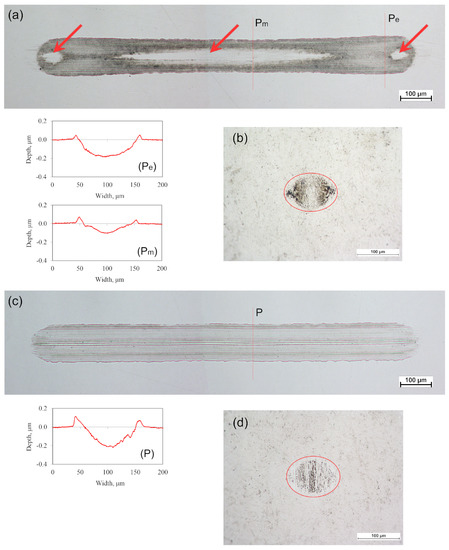
Figure 9.
Optical images and cross-section profiles of wear traces on the plate (a,c) and wear scars on the ball (b,d) observed after the IL-DEE tribo-test at 30 and 80 °C, respectively. P, Pm, and Pe are the cross-section profiles of the wear trace measured in particular locations. The arrows point out the lighter areas in the wear trace.

Table 2.
Wear volume and wear scar diameter observed in IL-DEE tribo-test using it as a neat lubricant.
The different worn surface morphology was observed during the tribo-test at different temperatures. At a temperature of 30 °C, the width and depth of the wear trace vary throughout its length—in the middle, it is narrower and shallow, while at both ends, it is deeper and broader. The profiles Pe and Pm shown in Figure 9 represent the cross-sections of the wear trace at the ends and in the middle, respectively. These profiles replicate the shape of the counter body because almost no wear occurs on the ball. Due to plastic deformation, part of the plates’ material was pushed to the edges of the wear trace. These appear as uplifts on the sides of the cross-section profile. Of course, this material part is considered when wear volume is calculated. It is evident from these profiles that more intense wear appears at the ends of the wear trace. This phenomenon appears in a reciprocation motion when a high-viscosity lubricant is used. After the tribo-test at 30 °C, lighter areas were observed in the wear trace (Figure 9a). Interestingly, these areas are located where the highest contact pressure is applied. EDS analysis shows that lighter areas have fewer tribo-film-forming elements, namely oxygen, carbon, and nitrogen (Table 3).

Table 3.
Atomic [%] composition of the wear traces on the plate.
At a temperature of 80 °C, the wear trace patterns have changed (Figure 9c). Moreover, according to its cross-section profile, it has the same size throughout its length. There are also a few minor scratches in the wear trace. According to the wear volume, the higher test temperature resulted in increased wear, which is not in line with the friction results. However, it may be that the majority of wear occurred during the running-in period. Therefore, this could explain why a high coefficient of friction was observed at the onset of the tribo-test. Figure 10 presents high-magnification SEM images of wear traces. It is evident from these images that the wear trace formed during the tribo-test at 30 °C is smoother and contains only short, tiny scratches, while at the temperature of 80 °C, more significant scratches occur. In both cases, the pushed-out material at the sides of the wear trace is seen, which was also evident in the cross-section profiles Pe, Pm, and P (Figure 9).
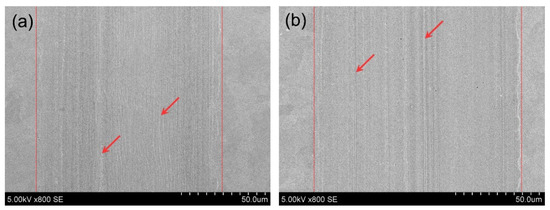
Figure 10.
SEM images of segments of wear traces on the plate formed during the IL-DEE tribo-test performed at the temperatures of 30 °C (a) and 80 °C (b). Arrows indicate scratches, lines—boundaries of the wear trace.
According to EDS analysis, the worn surfaces after the tribo-test at 80 °C have similar amounts of active materials as the lighter areas in the tribo-test performed at 30 °C (Table 3). It suggests that the higher temperature induces tribo-film formation.
The heat in the frictional contact can be externally applied or occur due to the friction process. In the case of the tribo-test at the temperature of 80 °C, the specimens were externally heated and from the friction. On the other hand, during the low-temperature test, the heat was only generated due to friction. Consequently, the lighter areas in the wear trace (Figure 9a) were formed where the highest contact pressure occurs. Therefore, these areas possess similar composition. It must be noted that the entire plate surface, even outside the wear trace, also contains nitrogen. It means that ionic liquid is adsorbed on the surfaces without tribo-reactions. Similar adsorption phenomena were confirmed by Song et al., who studied ammonium-based ionic liquids [30].
The appearance of the wear scars on the ball is very similar for both test temperatures (Figure 9b,d). However, the measurements show that a slightly larger wear scar was formed at the lower test temperature, which is in contrast to the wear volume (Table 2). The reason behind that could be the width of the plate’s wear trace, which varies throughout its length. Therefore, the wear scar on the ball represents the plate’s widest section of wear trace.
The observed wear volume was also compared with oleic acid anion containing PIL. It was found that erucic acid containing PIL had better wear reduction ability at both temperatures of interest (Table 2). The reason behind this could be a thicker adsorption layer that erucic acid with a longer alkyl chain could provide.
3.3. Lubricity of PIL as an Additive in Water
The variation of the coefficient of friction and its mean value observed using IL-DEE as an additive in water is presented in Figure 11. Lubrication with pure water resulted in very high and unstable friction. Applying one wt.% of IL-DEE reduced friction by 3.9 times. The lubrication with an additized sample resulted in much more stable friction, which had a running-in period of almost 10 min at the onset of the test.

Figure 11.
Variations of the coefficient of friction and its mean value observed during the W + IL-DEE tribo-test. * value of the coefficient of friction observed in our previous study [33].
In the present case, we also wanted to evaluate the influence of fatty acid anions on lubricity. Comparing the results from a previous study where bis(2-hydroxyethyl)ammonium oleate was used as an additive in the water; we found that PILs with different anions similarly performed (Figure 11). Only a 3.3% difference in favor of the oleic acid anion was obtained.
Similar to the coefficient of friction, lubrication with W + IL-DEE solution resulted in effective wear reduction (Table 4). Compared to additive-free water, the wear was reduced by 1.9 times. However, the wear was 14.5% higher than that observed in the case of the oleic acid anion [33]. There could be a few reasons for that. Firstly, the concentration of the additive, which worked well for oleic acid anion containing protic ionic liquid, may not work for erucic acid anion with PIL. Therefore, the concentration of the bis(2-hydroxyethyl)ammonium erucate additive should be determined to obtain optimum results. Secondly, the reactivity of shorter alkyl chains containing ionic liquids is higher. Therefore, oleic acid anion with PIL has an advantage.

Table 4.
Wear volume and wear scar diameter observed in W + IL-DEE tribo-test.
The wear traces on the plate appear to have minor scratches oriented along the sliding direction (Figure 12a). However, the wear scar on the ball has no scratches (Figure 12b). Therefore, scratches on the wear trace were formed due to three-body wear when wear debris came into contact. The high-resolution SEM image shows those scratches in more detail (Figure 13). Moreover, a small amount of material is accumulated at the sides of the wear trace, which is already evident in the cross-section profile (Figure 12). It was probably formed due to plastic deformation when relatively soft plate metal was pushed from the central part of the wear trace.
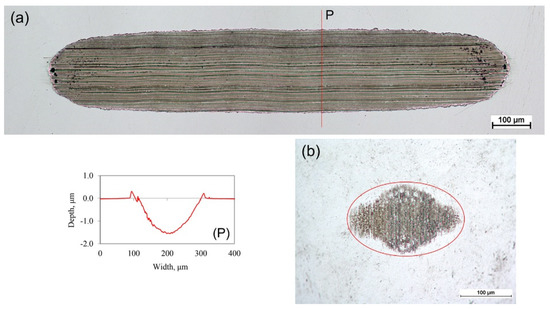
Figure 12.
Optical image and cross-section profile of wear trace on the plate (a) and wear scar on the ball (b) formed during the W + IL-DEE tribo-test P is the cross-section profile of the wear trace measured in a particular location.
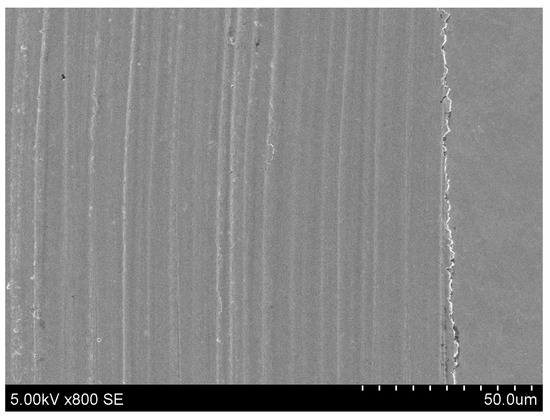
Figure 13.
SEM images of a segment of wear trace on the plate formed during the tribo-test of W + IL-DEE.
The EDS composition of the wear trace reveals the oxygen and carbon-rich layer (Table 5). In contrast, more than 7% nitrogen and very little oxygen and carbon were found on the intact plate surface. Even though IL-DEE is present in a small concentration in water, its molecules adsorb on the surface. During friction, rubbing between surfaces occurs, leading to the decomposition of this layer. It could lead to the formation of metal soap or friction polymers [34,35].

Table 5.
Atomic [%] composition of the wear traces on the plate observed after the tribo-test of W + IL-DEE.
4. Conclusions
Bis (2-hydroxyethyl)ammonium erucate protic ionic liquid was synthesized in this study. The relatively simple acid-base neutralization reaction at 100 °C for 24 h was carried out, forming tertiary amine salt. As a result, a dark yellow, very viscose liquid was obtained. The bis (2-hydroxyethyl)ammonium erucate was used as a neat lubricant and as a lubricity-enhancing additive in water. The following conclusions could be drawn:
- Synthesized PIL has exceptionally high viscosity at room temperature, which sharply drops with increased temperature. Therefore, a low viscosity index of 88.6 was observed.
- Bis (2-hydroxyethyl)ammonium erucate has good solubility in water. Therefore, dissolving up to 3% of PIL in this base fluid leads to a homogeneous solution, which shows no sedimentation or cloudiness.
- Using bis (2-hydroxyethyl)ammonium erucate as a neat lubricant or an additive resulted in a low coefficient of friction and low wear. The adsorbed layer, temperature-induced tribo-reaction layer, and metal soap formation are suggested to be responsible for that.
- By comparing the results of previous studies, it was found that a longer alkyl chain erucic acid anion provides an ionic liquid with better tribological properties. However, the optimum concentration of bis (2-hydroxyethyl)ammonium erucate should be determined to perform best when used as an additive in water base lubricating fluids.
Author Contributions
Conceptualization, R.K.; Investigation, M.G., A.K. and J.T.; Methodology, R.K. and A.K.; Project administration, R.K.; Resources, E.S.; Supervision, E.S. and R.K.; Validation, R.K., M.G. and A.K.; Visualization, J.T., R.K. and M.G.; Writing—original draft, R.K. and E.S.; Writing—review and editing, R.K. and E.S. All authors have read and agreed to the published version of the manuscript.
Funding
This research was funded by grant No. S-MIP-21-61 from the Research Council of Lithuania.
Institutional Review Board Statement
Not applicable.
Informed Consent Statement
Not applicable.
Data Availability Statement
Not applicable.
Conflicts of Interest
The authors declare no conflict of interest.
References
- STATISTA Global Demand for Lubricants from 2000 to 2020, with a Forecast for 2023 and 2028. Available online: https://www.statista.com/statistics/411616/lubricants-demand-worldwide/ (accessed on 16 February 2023).
- El-Din, M.N.; Mishrif, M.R.; Kailas, S.V.; Suvin, P.S.; Mannekote, J.K. Studying the Lubricity of New Eco-Friendly Cutting Oil Formulation in Metal Working Fluid. Ind. Lubr. Tribol. 2018, 70, 1569–1579. [Google Scholar] [CrossRef]
- Najiha, M.; Rahman, M.; Yusoff, A. Environmental Impacts and Hazards Associated with Metal Working Fluids and Recent Advances in the Sustainable Systems: A Review. Renew. Sustain. Energy Rev. 2016, 60, 1008–1031. [Google Scholar] [CrossRef]
- Jeevan, T.P.; Jayaram, S.R. Tribological Properties and Machining Performance of Vegetable Oil Based Metal Working Fluids—A Review. Mod. Mech. Eng. 2018, 8, 42–65. [Google Scholar] [CrossRef]
- Bartz, W.J. Ecotribology: Environmentally Acceptable Tribological Practices. Tribol. Int. 2006, 39, 728–733. [Google Scholar] [CrossRef]
- Wang, X.; Li, C.; Zhang, Y.; Ding, W.; Yang, M.; Gao, T.; Cao, H.; Xu, X.; Wang, D.; Said, Z.; et al. Vegetable Oil-Based Nanofluid Minimum Quantity Lubrication Turning: Academic Review and Perspectives. J. Manuf. Process. 2020, 59, 76–97. [Google Scholar] [CrossRef]
- Nagendramma, P.; Kaul, S. Development of Ecofriendly/Biodegradable Lubricants: An Overview. Renew. Sustain. Energy Rev. 2012, 16, 764–774. [Google Scholar] [CrossRef]
- Mobarak, H.; Mohamad, E.N.; Masjuki, H.; Kalam, M.; Al Mahmud, K.; Habibullah, M.; Ashraful, A. The Prospects of Biolubricants as Alternatives in Automotive Applications. Renew. Sustain. Energy Rev. 2014, 33, 34–43. [Google Scholar] [CrossRef]
- Woma, T.Y.; Lawal, S.A.; Abdulrahman, A.S.; Olutoye, M.A.; Ojapah, M.M. Vegetable Oil Based Lubricants: Challenges and Prospects. Tribol. Online 2019, 14, 60–70. [Google Scholar] [CrossRef]
- Lawal, S.A.; Choudhury, I.A.; Sadiq, I.O.; Oyewole, A. Vegetable-Oil Based Metalworking Fluids Research Developments for Machining Processes: Survey, Applications and Challenges. Manuf. Rev. 2014, 1, 22. [Google Scholar] [CrossRef]
- Gajrani, K.K.; Suvin, P.; Kailas, S.V.; Sankar, M.R. Hard Machining Performance of Indigenously Developed Green Cutting Fluid Using Flood Cooling and Minimum Quantity Cutting Fluid. J. Clean. Prod. 2019, 206, 108–123. [Google Scholar] [CrossRef]
- Hisham, S.; Kadirgama, K.; Ramasamy, D.; Noor, M.; Amirruddin, A.; Najafi, G.; Rahman, M. Waste Cooking Oil Blended with the Engine Oil for Reduction of Friction and Wear on Piston Skirt. Fuel 2017, 205, 247–261. [Google Scholar] [CrossRef]
- Owuna, F.; Dabai, M.; Sokoto, M.; Dangoggo, S.; Bagudo, B.; Birnin-Yauri, U.; Hassan, L.; Sada, I.; Abubakar, A.; Jibrin, M. Chemical Modification of Vegetable Oils for the Production of Biolubricants Using Trimethylolpropane: A Review. Egypt. J. Pet. 2020, 29, 75–82. [Google Scholar] [CrossRef]
- Nune, M.M.R.; Chaganti, P.K. Development, Characterization, and Evaluation of Novel Eco-Friendly Metal Working Fluid. Measurement 2019, 137, 401–416. [Google Scholar] [CrossRef]
- Edachery, V.; Ravi, S.; Badiuddin, A.F.; Tomy, A.; Kailas, S.V.; Suvin, P. Wetting Behaviour of a Green Cutting Fluid (GCF); Influence of Surface Roughness and Surface Energy of AA5052, Ti6Al4V and EN31. Mater. Today Proc. 2022, 62, 7605–7609. [Google Scholar] [CrossRef]
- Gajrani, K.K.; Suvin, P.; Kailas, S.V.; Mamilla, R.S. Thermal, Rheological, Wettability and Hard Machining Performance of MoS2 and CaF2 Based Minimum Quantity Hybrid Nano-Green Cutting Fluids. J. Mater. Process. Technol. 2019, 266, 125–139. [Google Scholar] [CrossRef]
- Shahabuddin, M.; Mofijur, M.; Kalam, M.; Masjuki, H. Study on the Friction and Wear Characteristics of Bio-Lubricant Synthesized from Second Generation Jatropha Methyl Ester. Tribol. Ind. 2020, 42, 41–49. [Google Scholar] [CrossRef]
- Zulkifli, N.; Kalam, A.; Masjuki, H.; Shahabuddin, M.; Yunus, R. Wear Prevention Characteristics of a Palm Oil-Based TMP (Trimethylolpropane) Ester as an Engine Lubricant. Energy 2013, 54, 167–173. [Google Scholar] [CrossRef]
- Zhou, Y.; Qu, J. Ionic Liquids as Lubricant Additives: A Review. ACS Appl. Mater. Interfaces 2017, 9, 3209–3222. [Google Scholar] [CrossRef]
- Zhou, F.; Liang, Y.; Liu, W. Ionic Liquid Lubricants: Designed Chemistry for Engineering Applications. Chem. Soc. Rev. 2009, 38, 2590–2599. [Google Scholar] [CrossRef]
- Morshed, A.; Wu, H.; Jiang, Z. A Comprehensive Review of Water-Based Nanolubricants. Lubricants 2021, 9, 89. [Google Scholar] [CrossRef]
- Azman, N.F.; Samion, S. Dispersion Stability and Lubrication Mechanism of Nanolubricants: A Review. Int. J. Precis. Eng. Manuf. Technol. 2019, 6, 393–414. [Google Scholar] [CrossRef]
- Kumar, S.S. Ionic Liquids as Environmental Friendly Cutting Fluids-A Review. Mater. Today Proc. 2020, 37, 2121–2125. [Google Scholar] [CrossRef]
- Amiril, S.A.S.; Rahim, E.A.; Syahrullail, S. A Review on Ionic Liquids as Sustainable Lubricants in Manufacturing and Engineering: Recent Research, Performance, and Applications. J. Clean. Prod. 2017, 168, 1571–1589. [Google Scholar] [CrossRef]
- Espinosa, T.; Sanes, J.; Jimenez, A.-E.; Bermúdez, M.D. Protic Ammonium Carboxylate Ionic Liquid Lubricants of OFHC Copper. Wear 2013, 303, 495–509. [Google Scholar] [CrossRef]
- Espinosa, T.; Jiménez, M.; Sanes, J.; Jiménez, A.-E.; Iglesias, M.; Bermúdez, M.-D. Ultra-Low Friction with a Protic Ionic Liquid Boundary Film at the Water-Lubricated Sapphire–Stainless Steel Interface. Tribol. Lett. 2014, 53, 1–9. [Google Scholar] [CrossRef]
- Avilés, M.-D.; Sánchez-Rodríguez, C.; Pamies, R.; Bermúdez, M.-D.; Carrión-Vilches, F.-J.; Sanfelix, S.G.; Kjøniksen, A.-L. New Water-Ethylene Glycol Lubricants with Stearate Ionic Liquid Crystal Additive. Lubricants 2022, 10, 241. [Google Scholar] [CrossRef]
- Angell, C.A.; Ansari, Y.; Zhao, Z. Ionic Liquids: Past, Present and Future. Faraday Discuss. 2012, 154, 9–27. [Google Scholar] [CrossRef]
- Avilés, M.; Carrión, F.; Sanes, J.; Bermúdez, M. Effects of Protic Ionic Liquid Crystal Additives on the Water-Lubricated Sliding Wear and Friction of Sapphire against Stainless Steel. Wear 2018, 408, 56–64. [Google Scholar] [CrossRef]
- Song, Z.; Liang, Y.; Fan, M.; Zhou, F.; Liu, W. Ionic Liquids from Amino Acids: Fully Green Fluid Lubricants for Various Surface Contacts. RSC Adv. 2014, 4, 19396–19402. [Google Scholar] [CrossRef]
- Iglesias, M.; Gonzalez-Olmos, R.; Cota, I.; Medina, F. Brønsted Ionic Liquids: Study of Physico-Chemical Properties and Catalytic Activity in Aldol Condensations. Chem. Eng. J. 2010, 162, 802–808. [Google Scholar] [CrossRef]
- Kreivaitis, R.; Gumbytė, M.; Kupčinskas, A.; Kazancev, K.; Makarevičienė, V. Investigating the Tribological Properties of PILs Derived from Different Ammonium Cations and Long Chain Carboxylic Acid Anion. Tribol. Int. 2020, 141, 105905. [Google Scholar] [CrossRef]
- Kreivaitis, R.; Gumbytė, M.; Kupčinskas, A.; Kazancev, K.; Na Ta, T.; Horng, J.H. Investigation of Tribological Properties of Two Protic Ionic Liquids as Additives in Water for Steel–Steel and Alumina–Steel Contacts. Wear 2020, 456, 203390. [Google Scholar] [CrossRef]
- Kreivaitis, R.; Kupčinskas, A.; Gumbytė, M.; Treinytė, J. Tribological Properties of Bis(2-hydroxyethyl)ammonium Oleate in Glycerol and Polyethylene Glycol Aqueous Solutions. J. Mol. Liq. 2023, 369, 120933. [Google Scholar] [CrossRef]
- Furey, M.J.; Kajdas, C.; Kempinski, R. Applications of the Concept of Tribopolymerisation in Fuels, Lubricants, Metalworking, and “minimalist” Lubrication. Lubr. Sci. 2002, 15, 73–82. [Google Scholar] [CrossRef]
Disclaimer/Publisher’s Note: The statements, opinions and data contained in all publications are solely those of the individual author(s) and contributor(s) and not of MDPI and/or the editor(s). MDPI and/or the editor(s) disclaim responsibility for any injury to people or property resulting from any ideas, methods, instructions or products referred to in the content. |
© 2023 by the authors. Licensee MDPI, Basel, Switzerland. This article is an open access article distributed under the terms and conditions of the Creative Commons Attribution (CC BY) license (https://creativecommons.org/licenses/by/4.0/).